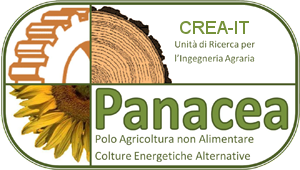Even if Short Rotation Forestry (SRF) poplar harvesting and chipping in a single operation seems to have good results, using this harvesting system some drawbacks have been pointed out. They are related to the high moisture content of the product obtained that can lead to fermentation during the storage period, the need of increasing the harvest window and the need of reducing the compaction of the wet soil due to the harvester passage. In order to avoid this problems, Panacea group designed two innovative systems for SRF harvesting in two different phases .
The first system was developed years ago, and now is commercialized by ZPZ firm, the second system was developed last year and is described in this paper, the two systems are:
- Felling and piling plants on the plot border followed by a subsequent chipping by the
means of a fixed chipper provided with a hydraulic support with pliers;
- Felling and windrowing among the rows for subsequent chipping by a fixed chipper provided with a rotating pick-up.
The second system, presented in this paper, require the use of the light felling machine during the winter; the introduction of the heavy chipping machine and tractor trailers onto the field is postponed after April or May, when the ground permit the passage of the machine without any consequences for the compaction of the soil. In fact during the winter rainy periods can make the fields unworkable for long period, therefore the number of days effective for the harvesting using choppers can be not sufficient. Thus, a felling machine that is lighter than other machines and postpone the chipping phase when the ground is dry can be a solution for lower compaction of the soil.
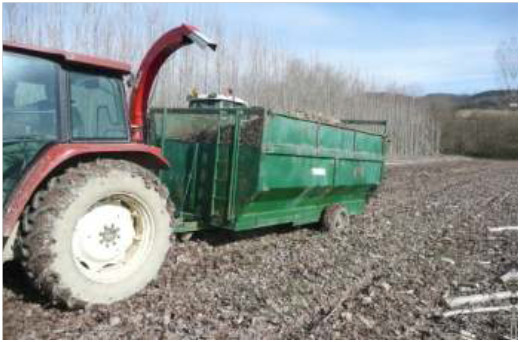 Within the Mipaaf “Bio-energy” project, Panacea designed a prototype for SRF poplar felling and windrowing that was the built by Spapperi Company (of Città di Castello). It was the developed a rotating pick-up device to be mounted on the mower, chopper and loader machine already produced by Spapperi for harvesting and chipping the windrowed plants. So, the experimental tests to verify the machines performance were started.
Within the Mipaaf “Bio-energy” project, Panacea designed a prototype for SRF poplar felling and windrowing that was the built by Spapperi Company (of Città di Castello). It was the developed a rotating pick-up device to be mounted on the mower, chopper and loader machine already produced by Spapperi for harvesting and chipping the windrowed plants. So, the experimental tests to verify the machines performance were started.
The harvesting tests of the felling and windrowing machine were conducted on 10 March 2009 close to Boccaleone, district of Argenta, in collaboration with the PowerCrop Company.
The felling prototype was equipped with a tractor Case JXC 1095, 4500 cc and 60 kW of power.
The harvesting and chipping tests were conducted in February 2009 in Città di Castello, on a poplar cultivation previously used for felling machine development. The unit was composed of a tractor Fendt 930 Vario, 6870 cc and with 228 kW of power, combined to a harvester provided with a pick-up together with a New Holland TL 80 tractor, 3900 cc with a power of 56 kW, towing a Bellucci and Rossini cart (12,5 m3) for the chiappe unloading.
The Machine for SRF Cutting andWindrowing
The prototype fells the plants and places them on the inter-row in a position parallel to the advancing direction of the tractor.
The prototype for cutting and felling the aligned plants in the inter-row is a semi-towed machine with a tractor at a minimum power of 60 kW (see Table below). The machine has a total mass of 1,000 kg and outside side play of 3,060 mm when it is working, and it mounts a set of cutting, conveyor and transporting devices (in addition to devices serving to orient plants towards the inter-row) on a metal structure.
|
Description |
Unit of measurement |
Values |
|
Side play in working phase (width and lenght) |
m |
3,06 x 2 (4,4) Maximum length including metal bar for unloading |
|
Side play in trasporting phase (width and lenght) |
m |
2 x 3,50 |
|
Maximum height |
m |
2,8 |
|
Total mass |
Kg |
1000 |
|
Pneumatics |
205/65/15 |
|
|
Cutting system |
||
|
Diameter of the circular blade |
mm |
650 |
|
Circular blade and tooth thickness |
mm |
6-8 |
|
Tooth |
N° |
97 |
|
Rotation speed |
rpm |
2000-2200 |
|
Minimum height of cut |
mm |
50 |
|
Conveyor system |
||
|
Metal structure/channel |
N° |
1 |
|
Cardan joint protection shield |
N° |
1 |
|
Toothed chain |
N° |
1 |
|
Length |
Pitches |
40 |
|
Working length |
Mm |
940 |
|
Tooth |
N° |
10 |
|
Height from ground |
M |
1,4 |
|
Tooth in the ring gear |
N° |
10-10 |
|
Transport system |
||
|
Metal structure/channel |
N° |
1 |
|
Higher and median toothed chain |
N° |
2 |
|
Length |
Pitches |
88 |
|
Working length |
Mm |
2250 |
|
Tooth |
N° |
22 |
|
Tooth for ring gear-left and right mast |
N° |
18 -10 |
|
Higher chain: height from ground |
M |
1,78 |
|
Middle chain: height from ground |
M |
1,18 |
|
Lower toothed chain |
N° |
1 |
|
Length |
Pitches |
72 |
|
Working length |
Mm |
130 |
|
Tooth |
N° |
18 |
|
Height from ground |
M |
1,30 |
|
Tooth in the ring gear |
N° |
10 – 10 |
|
Unload system |
||
|
Structure of main metal |
N° |
1 |
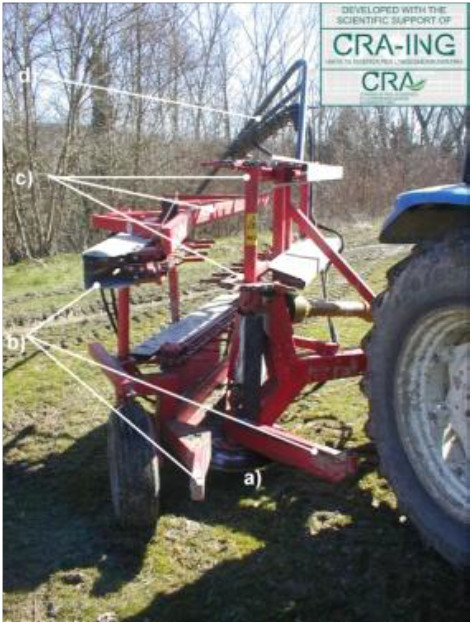 The cutting system consists of a blade of diameter and width of 650 mm and 6 mm, respectively. The blade movement originates from the tractor power take-off and makes cuts at a rotation speed of 2,000-2,200 rpm. The two idle wheels on which the machine is put, play the triple role of holding the machine while it works, facilitating the interception of the plant by the conveyor system (being that the wheels idle on their own axis, they allow the alignment of the machine to the rows of the plant) and adjusting the cutting height.
The cutting system consists of a blade of diameter and width of 650 mm and 6 mm, respectively. The blade movement originates from the tractor power take-off and makes cuts at a rotation speed of 2,000-2,200 rpm. The two idle wheels on which the machine is put, play the triple role of holding the machine while it works, facilitating the interception of the plant by the conveyor system (being that the wheels idle on their own axis, they allow the alignment of the machine to the rows of the plant) and adjusting the cutting height.
The conveyor system comprises a toothed chain and two metal sections.
The chain is placed at 1,400 mm from the ground and it rotates around two ring gears made of 10 teeth 750 mm apart, for a working width of 940 mm.
The plant is pushed towards the conveyor system from the tractor in the advancing phase and then intercepted by the transport system, which consists of three toothed chains and a metal section. The chains are placed at heights of 1,780 mm, 1,180 mm and 780 mm. The upper and medium chains, with lengths 88 double pitches placed on the same vertical axis, are spaced 600 mm from one another and they slide around two ring gears (18- and 20-toothed) that are mounted on two posts/shafts at a distance of 1860 mm, for a working length of 2250 mm. The lower one, with a length 72 double pitches, is placed opposite to the first two chains and runs around two ring gears (10-toothed), for a working length of 1750 mm. The metal section, 2279 mm in length, is placed at a height of 1762 mm.
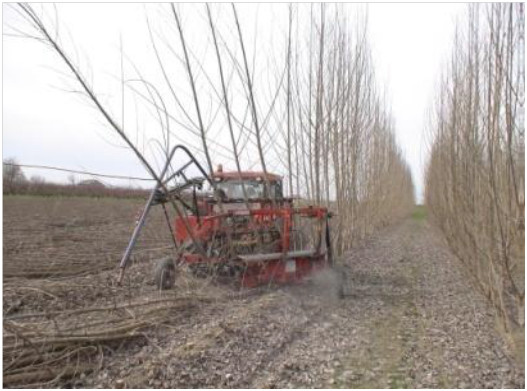 According to this system, the cut plant, still standing, is transferred to the centre of the inter-row.
According to this system, the cut plant, still standing, is transferred to the centre of the inter-row.
At the end of this process, the baseline is slightly retained, whereas the apical part of the plant falls into the inter-row aided, on the side, by an automatic positioning metal section that permits to it to fall in a position parallel to the advancing direction of the machine.
Combined to the unloading device, there is a chain (14-toothed) that, rotating at a speed faster than that of the tractor, has the function of, facilitating the collapse of the trees in the opposite direction to the advancing direction of the machine. The chain, which has 56 double pitches, is placed at 2005 mm from the ground and rotates around the ring gear (10-toothed), for a working length of 135 mm.
The windrowing of the first plants of a row can cause some problems, especially to the occupation of headlands, thus, preventing or blocking the passage of the machines for the subsequent harvesting and chipping. In order to avoid this problem, the machine was provided with an automatic positioning steel bar aimed at holding the first cut plants to let them fall after passing a few more meters along the ground. The movement of the toothed chains takes place by a self-hydraulic system that allows for the adjustment of the rotation speed in relation to the crop features and to the tractor advancing speed. All of the chains mounted on the prototype have a double pitch of 49 mm (chain link thickness = 15 mm), and from one side, they are protected by a sheet of steel (thickness = 1.20 mm). The dimensions of the tooth on the chain are 125 mm in length, 20 mm in thickness, and a spacing, on average, of 200 mm from each other.
The Machine for Harvesting and Chipping the Windrowed Plants
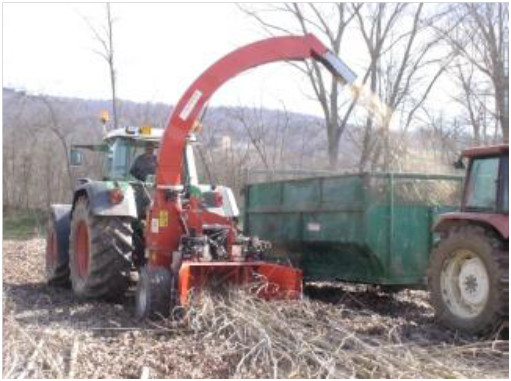 A pick-up device to be mounted on the Spapperi commercial mower, chopper and loader was also developed. In this way, the same machine can operate both on standing plants and on those windrowed by just changing the frontal device. The machine is able to advance along the inter-rows chipping the plants previously felled and left in the windrow and unload the product onto a trailer towed by a tractor. The Spapperi commercial mower, chopper and loader, on which the pick-up device was mounted, was modified by the introduction of a new device for harvesting the felled and windrowed plants, by a sheet-steel covering the plant-cut discs, and by adding vertically toothed rolls.
A pick-up device to be mounted on the Spapperi commercial mower, chopper and loader was also developed. In this way, the same machine can operate both on standing plants and on those windrowed by just changing the frontal device. The machine is able to advance along the inter-rows chipping the plants previously felled and left in the windrow and unload the product onto a trailer towed by a tractor. The Spapperi commercial mower, chopper and loader, on which the pick-up device was mounted, was modified by the introduction of a new device for harvesting the felled and windrowed plants, by a sheet-steel covering the plant-cut discs, and by adding vertically toothed rolls.
The pick-up device gathers plants from the ground, and the advancing motion of the tractor together with the conveyor device, aids their movement towards the feeding rolls of the chipping device. In this way, the product is chipped and unloaded on trailers.
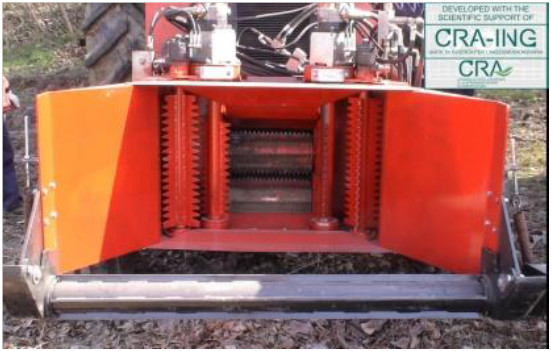 The gathering device was made up of a cylindrical-shaped and rotating pick-up (diameter = 110 mm and length = 1690 mm) provided with four steel bars (thickness = 10 mm and height = 30 mm) aimed at taking and lifting the basal part of plants. Its rotation axis is spaced 540 mm away from the chipper supply system (with a 465 mm space for discharging probable extraneous materials.
The gathering device was made up of a cylindrical-shaped and rotating pick-up (diameter = 110 mm and length = 1690 mm) provided with four steel bars (thickness = 10 mm and height = 30 mm) aimed at taking and lifting the basal part of plants. Its rotation axis is spaced 540 mm away from the chipper supply system (with a 465 mm space for discharging probable extraneous materials.
The rotation movement of the pick-up originates from a hydraulic pump placed on the left side. A valve can adjust the rotation speed according to the advancing speed of the machine as well as the quantity of biomass on the ground. A “idle” self-levelling system was mounted on both sides of the pick-up in order to guarantee contact between the gathering device and the ground. The conveyor device was extended by a new funnel-shaped instrument (width = 1750 mm) aimed at orientating the basal parts of the plants that are not perfectly aligned in the centre of inter-row towards the chipper supply system.
The felling and windrowing proof were conducted close to a poplar plantation of second-year growth (R2S2: Roots 2 years – Stalks 2 years) of AF2 clones.
Surveys in the field show that the average distance among the rows and on the row correspond to 3.51 m and 0.50 m, respectively, with a density of 5667 plants/ha. The percentage of leaks was 1.68% on average.
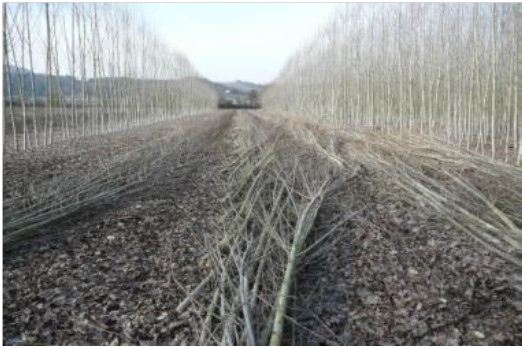 The rectangular-shaped and level field spanned a total area of 3.3 ha (net area of 3.10 ha) and comprised 39 rows of 206 m in average length. The crop seemed to be in a good condition of plant health and without any weeds. The height and the average diameter of the plants were 7.35 m (SD± 0.82) and 70.66 mm (SD±15.98), whereas the maximum diameter of the plantation was 120 mm. The tests with the harvester-chipping machine was conducted on three windrows, for a total length of 450, on an experimental plantation at four years of growth that had never before been harvested (R4S4). The plantation was established in March 2005 with cuttings of different kinds of clones. The density of the planting was 6194 plants/ha. The height and average diameter of the plants were 7.86 m (SD±1.75) and 77.40 mm (SD±31.46), respectively. The maximum diameter of the planted trees was 183 mm (see Table below).
The rectangular-shaped and level field spanned a total area of 3.3 ha (net area of 3.10 ha) and comprised 39 rows of 206 m in average length. The crop seemed to be in a good condition of plant health and without any weeds. The height and the average diameter of the plants were 7.35 m (SD± 0.82) and 70.66 mm (SD±15.98), whereas the maximum diameter of the plantation was 120 mm. The tests with the harvester-chipping machine was conducted on three windrows, for a total length of 450, on an experimental plantation at four years of growth that had never before been harvested (R4S4). The plantation was established in March 2005 with cuttings of different kinds of clones. The density of the planting was 6194 plants/ha. The height and average diameter of the plants were 7.86 m (SD±1.75) and 77.40 mm (SD±31.46), respectively. The maximum diameter of the planted trees was 183 mm (see Table below).
|
Planting |
Unit |
Felling windrowing machine |
Pick-up chopper |
||
|
Planting age |
year |
2 |
4 |
||
|
Plants years |
year |
2 |
4 |
||
|
Planting distance |
m |
3,50x0,50 |
3x0,5 |
||
|
Effective density |
Plants/ha |
5667 |
6194 |
||
|
Variety |
AF2 |
Euro-american” hybrids |
|||
|
Net area |
ha |
3,2 |
0,1 |
||
|
Average diameter of stalks |
mm |
70,66 |
77,40 |
||
|
Average height of the plants |
m |
7,35 |
7,86 |
||
|
Stalks per plant |
n |
1 |
1 |
||
|
Moisture |
% |
60,80 |
-- |
||
|
Fresh biomass (estimated) |
t/ha |
50,86 |
-- |
||
|
Dry biomass |
t/dm/ha |
19,93 |
-- |
||
The windrows were regular and parallel to the advancing direction of the machine. In this way, subsequently, correct harvesting and chipping will be possible. Product losses represented 1.97% of the cut-windrowed product, whereas the cut height was between 60 and 68 mm. From this harvesting proof, a positive evaluation of both the harvester functionality and the technical modifications has been possible. The machine innovations are needed for successfully gathering all of the felled plants and conveying them towards the feeding of the chipping apparatus. Although the proof carried out provided positive data for the perfect rotation speed of the pick-up in relation to the advancing speed of the machine, in the future, further improvements will be necessary for improving the harvester performance.
The heavy rainfall occurred in the just ended winter have significantly reduced the number of days of workability of soils, especially for sites that support the use of heavy machinery and carts, with serious repercussions on the biomass market. The farmer was found in terms of being unable to sell their product, companies of contractors responsible for the harvesting and provision of the chips have not been able to operate on their territory and were forced to postpone by one year to the next round of coppicing with all the technical problems related to the use of machinery on larger plants.
This innovative unit could represent a solution for the SRF harvest in rainy winters. The light, felling-windrowing machine was, in fact, able to work during the winter, postponing the use of the chopper and loader machine as well as trailers until April or May. The machine, in the experimental proof, showed a good performance with a 1.20 ha/h working capacity.
The development of such a prototype represents the first step for the future development of a new machine with an optimal performance for grounds of low bearing capacity soils.
A new machine that functions similarly but can work on two rows simultaneously could further reduce harvesting times, reducing costs as well could guarantee the maintenance of plant operations by preserving an inter-row free (when harvesting two of them simultaneously).
The performance of the harvester provided with a pick-up device between March and May, especially for infested plants, as well as the moisture content trend of the windrowed product, and the quality of the chip with different degrees of moisture are now under evaluation. In short, the new machines could be a good alternative to the heavier machines, especially on clay soil, for which the harvesting period is closely connected to the relationship between the machine weight and the low bearing capacity soils of the ground.
